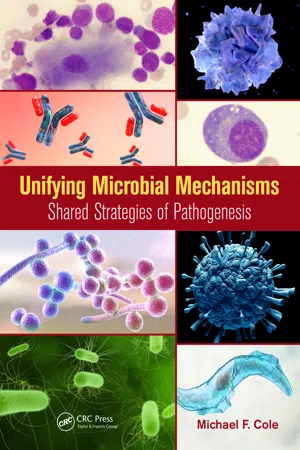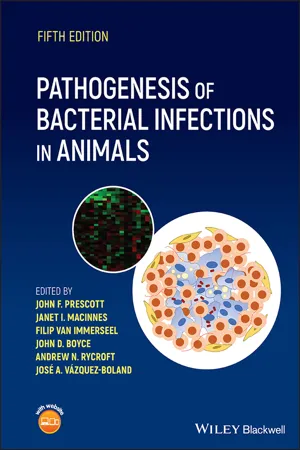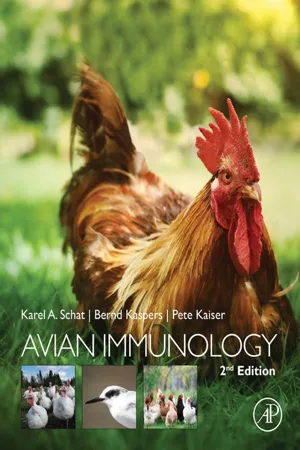Biological Sciences
Immune Evasion
Immune evasion refers to the strategies employed by pathogens, such as viruses and bacteria, to avoid detection and destruction by the host's immune system. These strategies can include disguising themselves to appear as self, inhibiting immune cell function, or directly attacking immune cells. By evading the immune response, pathogens are able to establish infection and persist within the host.
Written by Perlego with AI-assistance
Related key terms
Related key terms
1 of 4
Related key terms
1 of 3
4 Key excerpts on "Immune Evasion"
- Julius Kreier(Author)
- 2022(Publication Date)
- Routledge(Publisher)
Fetal development occurs in a sterile environment whereas newborn mammals are exposed to many environmental pathogens. During the first weeks after birth, newborn mammals are protected by antibodies that are derived from the mother. Human babies receive maternal antibody of the IgG class across the placenta during fetal development and additional classes of antibody in colostrum which accumulates in the mammary gland during the last few weeks of pregnancy. The structure of the placenta in domestic cattle and some other mammal species precludes transfer of IgG to the fetus. Newborn mammals of these species obtain all of their maternal antibodies in the first milk, i.e., colostrum. The newborn digestive system does not degrade the antibodies, and the newborn gut epithelia allow their passage from the gut into the bloodstream. The maternal antibodies protect the newborn mammal from environmental pathogens during maturation and priming of its immune system. Maternal antibodies may also play a subtle role in regulating the antigenbinding specificity of lymphocytes that are maturing in the newborn.Passive immunity can also be produced by serum or cell transfer. This is a medical procedure in which immune products formed by one individual are transferred to a nonimmune individual. Variations on the theme include the collection of peripheral blood leukocytes from an individual, their stimulation with antigens or tumor cells or cytokines in vitro, and reinfusion into the original donor with a view toward enhancing immunity.HOST AND PATHOGEN INTERACTIONS
Immune Evasion Strategies of Pathogens
Some pathogens are capable of survival and replication in the absence of host species, but other pathogens have an absolute requirement for a host. Survival of the latter organisms requires both host availability and evasion of immune elimination at least until transmission to a new host. Host immune systems and pathogen Immune Evasion strategies are products of the coevolution of hosts and pathogens and development of both systems is an ongoing process.Immune responses are not always sufficient to control infections. During evolution pathogens have been selected to express a plethora of methods to prevent development of, or their destruction by, immune responses. Specific examples can be accessed by consulting PubMed at the web address given at the end of this chapter using appropriate search phrases such as "AIDs virus" and "Immune Evasion." lmmune evasion strategies expressed by different pathogens include (1) The inactivation of constitutive defenses by enzymes that destroy oxygen radicals, inactivate proteolytic enzymes, and prevent assembly of serum complement components that build the membrane attack complex. (2) The subversion of acquired immune responses by acquisition of a coat of host antigens or the induction of immunosuppressive cells. (3) The evasion of acquired antibody responses by the degradation of bound antibodies or surface antigenic variation. (4) The evasion of antibody-mediated destruction by “hiding-out” in cells. Some organisms use host complement factors to expedite their phagocytosis, while others have specialized cell invasion structures. Organisms that are phagocytosed are sometimes able to withstand the antimicrobial activities of the phagocytic cell through inactivation of hydrolytic enzymes and reactive oxygen intermediates in the phagocytic vacuole. Others counter the defense mechanisms of the phagosome and phagolysosome by escaping into the cell cytosol. (5) The subversion of acquired cell mediated immune responses by stealth technology. Some viruses prevent or limit assembly of pathogen-peptide fragments with MHC molecules thereby preventing their display on the cell surface and detection by T cells. (6) The manipulation of immune responses by the generation of molecules that mimic host cytokines or cytokine receptors thus confounding molecular communications within the immune system. (7) The direct suppression of immune function. The AIDS virus lives and replicates in a class of T cells that is involved in regulating responses of other lymphocytes, causing their depletion and subverting host immune competence. (8) The misdirection of immune responses. Some pathogens induce inappropriate immune responses, e.g., stimulate production of large am o un ts of antibody when efficient development of a T cell-mediated immune response is required for effective control, or vice versa. (9) Manufacture and release of large quantities of parasite capsular material to provide a smoke screen and to tie up host defenses.- eBook - ePub
Unifying Microbial Mechanisms
Shared Strategies of Pathogenesis
- Michael F. Cole(Author)
- 2019(Publication Date)
- Garland Science(Publisher)
Basic immunology, 5rd ed. Elsevier, St. Louis, MO.Alcami A. 2003. Viral mimicry of cytokines, chemokines and their receptors. Nature Reviews Immunology, 3(January): 37-50.Baena A, Porcelli SA. 2009. Evasion and subversion of antigen presentation by Mycobacterium tuberculosis. Tissue Antigens, 74(3): 189–204.Van Avondt K et al. 2015. Bacterial Immune Evasion through manipulation of host inhibitory immune signaling. PLoS Pathogens, March 5. doi:10.1371/journal.ppat.1004644.Bowie AG, Unterholzner L. Viral evasion and subversion of pattern-recognition receptor signalling. Nature Reviews Immunology, 8(December): 911–922.Brodsky FM et al. 1999. Human pathogen subversion of antigen presentation. Immunological Reviews, 168: 199–215.Brodsky IE, Medzhitov R. 2009. Targeting of immune signalling networks by bacterial pathogens. Nature Cell Biology, 11(5): 521–526.Castañeda-Sánchez JI et al. 2017. Chapter 8, B lymphocyte as a target of bacterial iInfections. In: Ed. Isvoranu G (Ed.), Lymphocyte Updates: Cancer, Autoimmunity and Infection. IntechOpen, London, UK. https://www.intechopen.com/books/lymphocyte-updates-cancer-autoimmunity-and-infection .Collette JR, Lorenz MC. 2011. Mechanisms of Immune Evasion in fungal pathogens. Current Opinion in Microbiology, 14: 668–675.Deitsch KW et al. 2009. Common strategies for antigenic variation by bacterial, fungal and protozoan pathogens. Nature Reviews Microbiology, 7(7): 493–503.Dinko B, Pradel G. 2018. Immune Evasion by Plasmodium falciparum parasites: Converting a host protection mechanism for the parasite’s benefit. Advances in Infectious Diseases, 6: 82–95.Feng Z-P et al. 2006. Abundance of intrinsically unstructured proteins in P. falciparum and other apicomplexan parasite proteomes. Molecular & Biochemical Parasitology, 150: 256–267.Fernandes RK et al. 2015. Paracoccidioides brasiliensis - eBook - ePub
- John F. Prescott, Janet I. MacInnes, Filip Van Immerseel, John D. Boyce, Andrew N. Rycroft, José A. Vázquez-Boland, John F. Prescott, Janet I. MacInnes, Filip Van Immerseel, John D. Boyce, Andrew N. Rycroft, José A. Vázquez-Boland(Authors)
- 2022(Publication Date)
- Wiley-Blackwell(Publisher)
5 Subversion of the Immune Response by Bacterial PathogensDouglas C. Hodgins Raveendra R. Kulkarni and Patricia E. ShewenIntroduction
The wide variety of bacterial pathogens that successfully infect and continue to affect humans and animals, despite the robust capabilities of host immune systems, demonstrates that these pathogens can evade, block, defeat, inactivate, overcome, or otherwise subvert immune defenses. With recent advances in experimental methods and analysis, understanding of the complexities of the immune system has progressed relentlessly. Insights into the molecular details of gene regulation, post‐transcriptional modifications, cellular signaling pathways, apoptosis, autophagy, and other cellular processes are accumulating rapidly. Investigations into mechanisms used by bacterial pathogens to subvert these processes lag somewhat behind, but it is clear that bacterial pathogens can counteract host defenses at the same high, or perhaps higher, level of sophistication. Indeed, some bacterial effectors are versatile in that they can target multiple points of host susceptibility.While the initial evidence for subversion of immune defenses may originate from computational analysis of extensive databases, confirmatory evidence comes from in vitro studies using established cell lines and model systems. However, in vitro studies have their own limitations in ascertaining whether proposed mechanisms actually enhance bacterial replication, persistence, or transmission in vivo in target host species. Some bacteria have multiple, overlapping mechanisms that must be deployed, in sequence, at critical time points to be advantageous to the pathogen.The material summarized in this chapter is presented in the context of existing evidence, with the recognition that future work may show that some of the mechanisms do not have clinical relevance. Although the subject of this book is bacterial pathogens of animals, some pathogens of humans have been included to illustrate certain precise mechanisms of subversion that have been well studied in the context of human medicine. Animal pathogens doubtless use some of these mechanisms, but this awaits confirmation. - eBook - ePub
- Bernd Kaspers, Karel A. Schat(Authors)
- 2012(Publication Date)
- Academic Press(Publisher)
2 ], to which we add “and suboptimal innate and cell-mediated responses.” Such dysfunction often results from infection of cells of the immune system, leading to their impaired function against the primary and subsequent infections in a non-specific manner. For this chapter, we define immunoevasion as “pathogen-initiated responses counteracting the immune responses to the specific pathogen.” The major difference is that immunosuppression is the consequence of the overall replicative strategy of the causative agent, resulting in increased susceptibility to other pathogens but not necessarily to the causative agent, while immunoevasion is achieved by specific pathogen-encoded determinants, primarily favoring replication of the causative agent. In some instances, infections can result in immunosuppression and immunoevasion—for example, infection with Marek’s disease virus (MDV).16.2 Immunosuppression
16.2.1 Introduction
Immunosuppression is a major problem for the poultry industry, but actual figures indicating the scale of the problem are difficult to find. Infection with pathogens and/or environmental factors, including management errors, can result in immunosuppression, and interactions between the two usually exacerbate the problem. In an excellent recent review article, Hoerr [3 ] examined the many environmental and infectious causes of immunosuppression in chickens and turkeys, which are complex and can have a major impact on profitability of broiler and layer flocks (Figure 16.1 ). Environmental stressors include the later period of incubation, hatching and chick handling. Other stressors include suboptimal housing conditions and mycotoxins. Any infection causing clinical disease may result in immunosuppression, but the focus here is on pathogen-induced immunosuppression in the absence of clinical disease.Figure 16.1 Immunosuppressive interaction in broiler chickens. A high-yield broiler may hatch in an energy-depleted state and be subjected to suboptimal handling and transportation systems, and experience delays in acquiring nutrition, all while processing attenuated live vaccines that produce cytolytic infections. The brooding environment may not meet thermoneutrality, and placement on reused litter creates the potential for exposure to ammonia and potentially immunosuppressive agents (e.g., MD, chicken anemia and enteric viruses). With the decline of maternal immunity, active infection by IBDV can be permanently immunosuppressive at or before 14 days of age and, at least transiently, immunosuppressive when it occurs at an older age. Also, with declining maternal immunity, CIAV can produce a cytolytic infection in the thymus and contribute to the immunosuppression initiated by IBDV. Following this sequence, it is possible for immunocompetency to be compromised in a variable percentage of the flock. This can contribute to increased severity of infections by respiratory viruses and the ability to control secondary respiratory infections by E. coli . Coccidiosis and gangrenous dermatitis may likewise emerge as problems from 25 days of age and older. Collectively, this sequence of events occurs to variable degrees and influences livability, feed conversion, condemnation at processing and total production cost. Each immunosuppressive influence represents a control point to prevent immunosuppression and improve health and welfare.Source: From Hoerr [3
Index pages curate the most relevant extracts from our library of academic textbooks. They’ve been created using an in-house natural language model (NLM), each adding context and meaning to key research topics.
Explore more topic indexes
Explore more topic indexes
1 of 6
Explore more topic indexes
1 of 4



